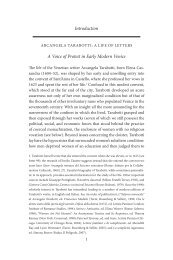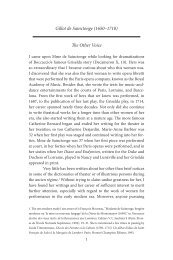Excerpt - Iter: Gateway to the Middle Ages and Renaissance
Excerpt - Iter: Gateway to the Middle Ages and Renaissance
Excerpt - Iter: Gateway to the Middle Ages and Renaissance
You also want an ePaper? Increase the reach of your titles
YUMPU automatically turns print PDFs into web optimized ePapers that Google loves.
28 Edi<strong>to</strong>r’s Introduction<br />
That art is formed from what is known:<br />
This point a Sophist easily<br />
Concedes under a deep sleep’s cover.<br />
For me, I say I quite agree—<br />
Love came first, before <strong>the</strong> Lover.<br />
Car, qui feit l’art, jà la sçavoit,<br />
Qui est un poinct qu’un Sophistique<br />
Concederoit <strong>to</strong>ut en dormant:<br />
Qu<strong>and</strong> à moy, je dy pour replique,<br />
Qu’Amour fut premier, que l’Amant. (55:4–8)<br />
The conclusion reminds <strong>the</strong> reader that Du Guillet, like her male<br />
counterparts, knew art <strong>and</strong> love, <strong>and</strong> <strong>the</strong> <strong>the</strong>ories in both domains. 62<br />
Each poet makes of <strong>the</strong>se what s/he can. The <strong>the</strong>oretical, yet ligh<strong>the</strong>arted<br />
argument reinforces <strong>the</strong> link between <strong>the</strong> experience of love<br />
<strong>and</strong> <strong>the</strong> practice of writing poetry <strong>and</strong> reminds us that two lovers/<br />
poets may have different, even opposing, points of view.<br />
Ano<strong>the</strong>r such philosophical debate occurs in poem 24, which<br />
weighs <strong>the</strong> relative importance of love <strong>and</strong> <strong>the</strong> lady for <strong>the</strong> lover.<br />
The epigram evokes <strong>the</strong> medieval tradition of <strong>the</strong> courts of love, still<br />
popular in <strong>the</strong> fifteenth <strong>and</strong> sixteenth centuries, as well as Ebreo’s<br />
influential dialogues, in which Philo assures Sophia that, “just as <strong>the</strong><br />
lover is prior <strong>to</strong> love, so is <strong>the</strong> beloved; for if <strong>the</strong>re were not a first<br />
lovable person or object, it would be impossible <strong>to</strong> love, <strong>and</strong> <strong>the</strong>re<br />
62. Leone Ebreo (Léon Hébreu) presents those <strong>the</strong>ories of art <strong>and</strong> love in his Dialoghi<br />
d’Amore. First published in Italian in 1535, <strong>the</strong> Dialoghi was an immensely popular work<br />
that circulated widely in numerous editions <strong>and</strong> several translations over <strong>the</strong> next twenty<br />
years. Pontus de Tyard’s French translation of <strong>the</strong> Dialogues was published by Jean de<br />
Tournes in Lyon in 1551, <strong>and</strong> may well have circulated in manuscript form in literary circles<br />
prior <strong>to</strong> its printing. The two characters of Ebreo’s dialogues are Filone (Philo, Greek for<br />
love) <strong>and</strong> Sofia (Sophia, Greek for wisdom or science)—who <strong>to</strong>ge<strong>the</strong>r represent <strong>the</strong> love<br />
of wisdom (i.e., philosophy). On <strong>the</strong> matter of <strong>the</strong>ory <strong>and</strong> practice in love, Sophia tells<br />
Philo, “you cannot deny that knowledge of <strong>the</strong> <strong>the</strong>ory should always precede application in<br />
practice, as it is reason which rule’s Man’s actions.” The Philosophy of Love (Dialoghi d’Amore)<br />
by Leone Ebreo, trans. F. Friedeberg-Seeley <strong>and</strong> Jean H. Barnes (London: The Soncino Press,<br />
1937), 233. I have cited <strong>the</strong> English translation in <strong>the</strong> remainder of this volume. For readers<br />
interested in <strong>the</strong> parallels between <strong>the</strong> French translation by Pontus de Tyard <strong>and</strong> Pernette<br />
du Guillet’s verse, I have also indicated <strong>the</strong> relevant page numbers in <strong>the</strong> modern critical<br />
edition of Tyard’s translation: Dialogues d’amour, trans. Pontus de Tyard, ed. T. Anthony<br />
Perry (Chapel Hill: University of North Carolina Press, 1974). For <strong>the</strong> French version of <strong>the</strong><br />
passage noted here, see Dialogues d’amour, 178.




